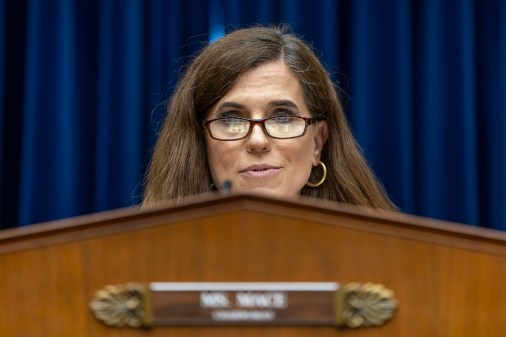Can the MGT Act keep IT modernization on track in the age of perpetual CRs?

The big appropriations package that funds the government through September has been a relief for the federal CIOs and IT professionals who were handcuffed for the first six months of fiscal 2018, as Congress and the White House enacted a series of temporary spending bills.
Until late March, agencies were essentially stuck maintaining basic IT operations without the necessary additional capital to start new development and modernization projects.
“It’s just among the worst business practices you could engage in — and yet here we are,” said former U.S. CIO Tony Scott, who still watches federal IT spending closely from the private sector. It’s all too familiar, with Congress regularly taking the appropriations process to the brink and funding the government with short-term continuing resolutions (CRs). “The constant ‘start, stop, hurry up’ is deadly in terms of project efficiency, morale, those kinds of things,” regardless of whether it’s IT or some other project, Scott said.
New legislation for CIOs, the Modernizing Government Technology Act, however, has the potential to alleviate some of the fiscal instability for IT modernization, allowing agency executives to dip into working capital funds to jumpstart new tech projects. The money in those funds won’t come directly from appropriations. Instead, agencies will stock them with savings from IT efficiencies — and the resulting spending can be spread out as far as three years.
With MGT, “we’re provided a security blanket,” said Dave Powner, director of IT issues for the Government Accountability Office.
Powner has heard of many agencies that find savings through their modernized IT but are afraid to report it for fear of getting funding for that program chopped and the savings taken away.
“If you save money, you can put it in those working capital funds to reinvest in priorities,” he told FedScoop. The law also created a revolving centralized tech fund that agencies can apply to draw from, currently with $100 million in it. But Powner sees the biggest impact coming from the agency working funds. “I think in many ways, that could end up paying far greater returns, the working capital funds, than the central fund, just because the amount the central fund is to be funded at. It’s not that much money when you start looking at it.”
Powner pointed to data centers as one part of the federal IT stack still ripe for agencies to modernize. The savings from that consolidation could be a quick way to inject money into those working capital funds.
But whether it’s by use of the MGT Act’s working capital funds or some other tool, modernization is going to require CIOs to think beyond one or two years out, especially if appropriators can’t or won’t.
“Managing large systems is a marathon: There are years of planning, upgrades, testing, and the like that make a major modernization effort successful,” said Frank Baitman, former CIO of the Department of Health and Human Services. “The only way to undertake such an effort is to have committed resources for the duration of the project.”
Working capital funds aren’t unique to the MGT Act. Some agencies, prior to MGT, already had working capital funds that help pay for IT. Mike Hettinger, a legislative strategist and consultant, and former congressional staffer for IT issues, said those agencies are “less affected by CRs and shutdowns and those sorts of things, they can do more planning.”
To Hettinger, those funds equate to better long-term work.
“It will be interesting to see…if over the next couple years agencies begin to get those [MGT] working capital funds up and operational, begin to capitalize those funds so there’s money in there, knowing that will give them a better opportunity to plan ahead,” he said. “I think that will benefit everyone.”
MGT Act author Rep. Will Hurd, R-Texas, said his focus is now on the idea that “at the end of this fiscal year, there’s two or three agencies that have been in a position to deposit money in their working capital funds and making sure that we’re working with OMB and the Office of American Innovation to ensure that we have those agencies being able to do that. I think that is — being able to prove structurally that this is possible to do — would be our kind of next big goal.”
Keeping the lights on during a CR
Federal CIOs and IT experts in particular will tell you a CR is especially detrimental to their efforts to update or replace decades-old technology, whether they’re hoping to fend off the next massive Office of Personnel Management-style breach, or trying to get their services up to speed with what Americans have come to expect in a private sector full of Ubers, Googles and Airbnbs.
Where IT modernization is all about looking forward and embracing new, emerging technologies, a CR keeps agencies trapped in the past.
“Essentially no new work can get done,” Scott said, describing the bleak job of a CIO during a CR.
“You’re typically, in a CR situation, only allowed to maintain current levels of activity. Most new application development or modernization or other activities that…are already behind and slow enough come to a grinding halt,” Scott said. “It’s adding to the problem and compounding it.”
Of course, federal agencies don’t live purely in a vacuum of single-year funding, budgeting and spending, despite Congress writing appropriations that way. Many CIOs develop longer-term visions for their technology development and adoption, and some are afforded those luxurious working capital funds that don’t expire after just a year.
But without the certainty of appropriations passed as law, it “makes it difficult for agencies to do the kind of planning you want to do that would allow you to effectively modernize your IT,” said Hettinger.
“Obviously a CR is better to the alternative, which could be a shutdown, but not nearly as productive as [an on-time appropriations bill], giving agencies the opportunity to look across the spectrum, know how much money they have to spend in a given year, and plan to spend that money effectively,” he said.
Continuing resolutions are nothing new in Washington. In fact, since 1977, Congress has passed all 12 required appropriations bills by the start of the fiscal year only four times —1977, 1989, 1995 and 1997 — requiring some sort of stopgap funding to kick off most other fiscal years.
“It’s not like it’s just recently broken,” Hettinger said. “It’s a process that’s been hard to deal with for decades, literally.”
But the imperative for tech modernization in recent years as Americans demand a more digital government has created a sort of inflection point as CIOs can no longer afford to simply keep the lights on. That’s also coupled with CRs becoming a de facto operational state rather than brief inconveniences.
“It’s very inefficient and ineffective at accomplishing the goals that I think most CIOs and, in fact, most of Congress would really like to see the IT organizations accomplish,” Scott said. “These CRs and potential shutdowns have just the opposite effect of what they say they want.”
Baitman, who also served as CIO of the Social Security Administration in addition to his time at HHS, said the CRs and shutdowns he experienced “were more than a simple distraction.”
“There’s a lot of work that staff does to prepare for a government shutdown: everything from determining which systems were critical and needed to be kept online to which staff were to be deemed essential,” Baitman told FedScoop. “All of those activities represent more than a simple “loss of time” working on modernization efforts, they undermine organizational planning. It’s really difficult to focus on a long-term investment when there are insufficient resources to cover operations this week.”
He added that it took a toll on his team mentally.
“It’s tough to take seriously the hard work of managing day-to-day operations when our political leaders don’t take seriously the business of government,” said Baitman, who now serves as an IT adviser and consultant in various roles. “For better or worse, that has a direct effect on team morale.”
Time for lawmakers to ‘look in the mirror’?
CIOs face an almost futile song and dance with overseers on Capitol Hill. So often, technologists are brought before a committee and chastised for their modernization struggles when the root of those struggles can often be traced back to lawmakers’ own political appropriations foibles.
“I think it’s time that we remind Congress that they’re the executive branch’s board of directors, and they should behave that way. The oversight that a Board provides any organization is vital to its integrity and success,” Baitman said. “Effective boards see their role as creating the environment and incentives for organizations to achieve success; if Congress created an environment for CIOs to succeed, I think we wouldn’t be discussing with the antiquated state of government technology today.”
Scott said Congress’ lack of accountability for CRs contributes to the hit in morale Baitman described.
“I can’t tell you the number of federal employees who every time when we were faced with one of these said how debilitating an effect it has on morale in their organization,” he said. “It’s literally kind of living day-to-day with this sword over your head. You can go through those a few times in your life, but to go through it every year or multiple times a year, as we’ve experienced now, just has a very numbing effect on employee morale. It’s like, ‘Here we go again. Do these guys really care?’”
It’s even worse for those CIOs reamed out on the Hill. “Almost nobody says ‘Look in the mirror, guys,'” Scott said. “But this is one of the major contributors.”
Hurd is one lawmaker willing to take the blame.
“It’s an absolute valid retort,” Hurd said.
Will Hurd, since taking office in January 2015, has been the leading voice for IT modernization on Capitol Hill, leading the House Oversight and Government Reform IT Subcommittee. Where many lawmakers tend to skip over the nitty, gritty technical details of agencies’ IT struggles to simplify them as examples of government waste, the technically literate Hurd thinks of himself as a partner to federal IT shops, working to give them the legislative “tools” they need to provide 21st century, digital services to the American public. The Modernizing Government Technology Act is a prime example of that.
“I look at this as you can’t hold people accountable if you don’t give them all the tools they need to do their job. And an ability to plan into the future is an important tool in order for a CIO to modernize their infrastructure or, at a minimum, do their job,” he said.
Hurd, though, is one of the few to admit how destructive political beef over larger issues like immigration can be to the government operations we take for granted. Rep. Gerry Connolly, D-Va., is another.
“Governing from one continuing resolution to the next is no way to run government and grinds to halt any progress towards modernizing agency IT infrastructure,” Connolly said in an emailed statement. Congress is working to provide the necessary tools for federal IT modernization, he said, but “agencies will struggle to meet IT needs if we fail to empower CIOs and provide a full fiscal year budget outlook.”
Hurd echoed his colleague from the other side of the aisle. In a CR,“CIOs are restricted from being able to do long-term planning. Modernization efforts are going to be hampered, without a doubt. And that’s one of the unfortunate things about having these CRs.”




